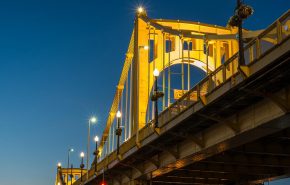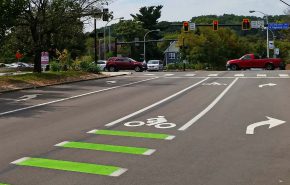Written by GAI Consultants’ Todd Wilson, PE and edited by local historian Helen Wilson, his mother, Pittsburgh’s Bridges (Images of America) features over 200 black and white images of bridges in the City proper.
Through short captions, the book discusses the design, construction, and at times, demolition of the bridges that shaped the “City of Bridges” from yesterday to today. The book is part of Arcadia Publishing’s Images of America series, which tells the stories of small towns, downtowns, local landmarks, and architecture across the country in the form of vintage images. GAI sat down with Todd to find out more about the book and what inspired him to undertake this project.
Congratulations on writing a book! How did you become involved with this project?
Todd: I’ve been writing bridge books unofficially for much of my life. In high school, I wrote an unpublished book about Pittsburgh’s river bridges, which helped me win a college scholarship from the Pittsburgh History and Landmarks Foundation (PHLF). In 2013, Arcadia Publishing contacted PHLF to see if they would write a book on Pittsburgh’s Bridges for their Images of America Series. Since I had already done a book with the Foundation, they came back to me because I was a perfect fit. I immediately said yes!
You’re a traffic/transportation engineer, so why do you take such an interest in bridges?
Todd: As a kid, I was fascinated with bridges. My father was a commercial photographer and he used to drive my brother and me around to take pictures of bridges. I have fond childhood memories of planning those day trips and reading maps. So I grew to love roads, highways, alignments, and the like, and understanding the whole process of getting somewhere. As a result, I ended up focusing on the highway and traffic aspect of civil engineering.
The engineers really pioneered a lot of the approaches that we take for granted or wouldn’t even consider attempting today due to safety concerns. In addition, I hope readers will appreciate the many challenges that the engineers overcame.
What makes this particular bridge book unique?
Todd: Most bridge books are written by historians and architects who don’t understand how bridges function. These books tend to categorize bridges by general appearance, which sometimes leads to incorrect conclusions. I thought it was important to contribute a technically sound book with some discussion of engineering. It was reviewed by several leading bridge engineers, including the retired Allegheny County and Pennsylvania Turnpike Chief Engineer, a retired Carnegie Mellon University structural engineering professor, and GAI’s own Ben Allis, PE.
What was one of the challenges you encountered in writing this book?
Todd: The publisher had set guidelines, so it was a challenge to fit everything into those parameters. For example, there was a minimum and maximum word count to describe photos, and the book had a fixed page count of 128 pages—because there are so many bridges in the Pittsburgh area, I had to narrow it down to bridges only in the City proper to fit that page limit.
Where did you find the images of the bridges?
Todd: The library, the City of Pittsburgh Department of Public Works, Allegheny County Department of Public Works, Carnegie Mellon University, a retired engineering professor, as well photographs I have taken over the years.
Who should read this book?
Todd: Anyone interested in bridges or history! It primarily consists of photographs, so hopefully it appeals to a broad audience.
What are some of the most important things you hope readers will take away from reading the book?
Todd: I hope readers will understand how innovative the construction methods were, even back then. The engineers really pioneered a lot of the approaches that we take for granted or wouldn’t even consider attempting today due to safety concerns. In addition, I hope readers will appreciate the many challenges that the engineers overcame. For example, in the 1900s, Pittsburgh had an Art Commission that had veto power over designs it didn’t like. In the 1920s, they only approved bridge designs that did not obstruct views from the roadways. So engineers had to create untried designs or sometimes put a bridge in a less efficient location to appease the Art Commission; today, these are some of the area’s most celebrated bridges. I hope readers understand how daring and creative these engineers were to come up with the solutions they did, and how much of a struggle it was to get a lot of these bridges built.
Do you document bridges in other areas? If so, where?
Todd: Yes, and because I’ve been photographing bridges for so long, I naturally keep going further and further away from Pittsburgh to photograph them. I’ve now photographed at least one bridge in all 50 states, in 14 countries, and in four continents. It’s exciting to have the opportunity to learn so much about how bridges vary across the country and throughout the world and to understand the transportation systems connecting them.
Pittsburgh’s Bridges (Images of America) is available in paperback at Pittsburgh bookstores, Arcadia Publishing, Amazon, and other online retailers. A Pittsburgh native and graduate of Carnegie Mellon University, Todd Wilson, PE is a professional engineer in GAI’s Pittsburgh office. He specializes in civil engineering for transportation projects, including traffic control and signaling, capacity analyses, and signing and pavement marking. For more information about his book, contact Todd at 412.476.2000.


